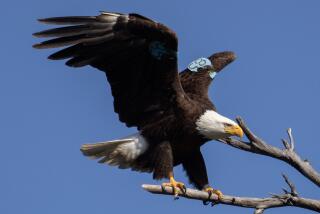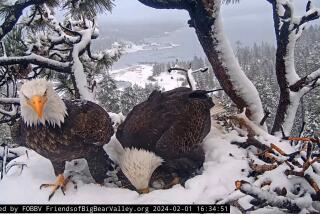Young Stars Preen as Their Webcast Takes Off
- Share via
GORHAM, Maine — Atop a great white pine, Big is venturing out on limbs now, spreading his or her wings in preparation for flight. Little, four days younger, also is branching out and should take to the sky soon.
The two bald eagles and their parents are the surprise superstars of a round-the-clock Internet reality show featuring love and adventure, flight and feeding -- and fatal sibling rivalry. The full-time eagle blog and video-stream was designed by a group of Maine scientists who wanted to help people connect with nature from their computers.
“It is just so exciting to reach out to people who aren’t necessarily interested in birds, not necessarily bird watchers, or even environmentalists -- just everyday folks, working at their computers,” said wildlife biologist Wing Goodale of the nonprofit Biodiversity Research Institute here. “And they are able to personally connect to these birds.”
Other video monitoring stations have been set up to observe bald eagles, but they have not reached the public in the same way.
Tens of thousands of Internet viewers watched (www.briloon.org/ed/eagle/index.htm) as the first eaglet -- known as Big -- hatched April 10. Within days, two more chicks followed. Goodale and state and federal scientists were thrilled too -- eagle triplets are rare in Maine, and this was a chance to observe them closely.
Life in the eagle family was idyllic at first. Mom sheltered her youngsters from brutal spring rains. Dad fetched nourishing meals of seagulls, crabs and the occasional rabbit, ears and all. Then the “Eaglecam” -- which is unedited -- captured a drama that shocked many viewers.
“I hoped what I had seen was erroneous,” one anonymous blogger wrote after the largest chick pecked the smallest to death. The big and middle babies then ate their deceased sibling.
“That was nauseating, but that’s nature for you,” commented another blogger.
Siblicide -- the murder of one sibling by another -- is not uncommon in the natural world, according to Mark McCollough, an endangered-species biologist in Maine for the U.S. Fish and Wildlife Service. The behavior is about dominance, he said.
“I was surprised that it greatly upset some people, even though as biologists we were trying to warn them that this kind of thing can happen,” McCollough said. “Some people were even calling -- saying, ‘Why didn’t you interfere?’ But we can’t do that. This is part of nature.”
The eagle family lives in Hancock County, close to Maine’s north coast. Associate biologist Theresa Daigle said the Biodiversity Research Institute does not disclose the exact location to avoid disturbing the birds.
Goodale said he found a spot near the pine and set up the weatherproof camera in January, training the lens on an existing nest. Eagle couples often return to the same sites year after year, he said, so the odds were good that the nest would be active. Sometimes, Goodale said, the birds will occupy an abandoned nest, so the scientists do not know for certain if the nesting pair came back to a familiar locale.
But whether it is their old home or a nest once occupied by other eagles, the birds made repairs after the winter’s damage as they prepared for offspring.
When the female began sitting in what biologists call the incubation position, “we were so excited,” Goodale said.
In quiet moments, the birds remain in their nest, preening -- basically, just hanging out. It is the avian counterpart of dull domesticity, Goodale said.
Recently, he said, the two offspring have begun to flap as they build up flight muscles. The young birds are nearly as large as their parents and could begin to fly any day. They likely will leave the nest for good in the fall.
Up to 10,000 viewers watch the eagles each day, Goodale said, down from a peak of nearly 30,000. The Biodiversity Research Institute spends about $2,000 a month on the eagle webcast, he said.
Updates from the biologists have helped cement the link to the birds that many Web visitors have come to feel, Goodale said. Some write on the blog that they watch the birds during family meals. One viewer, known as “Hello from NJ,” said simply: “I just can’t stop watching.”
Goodale, 32, said this “emotional, personal connection” is just what the scientists were hoping for.
“It’s so important,” he said. “When we talk about things like population statistics of eagles, how boring is that? But when we talk about how they live, and when people watch them, it establishes an important connection between animals and individuals.”
About 400 eagle couples have nests in Maine--compared with around 40 just 25 years ago, said McCollough, the U.S. Fish and Wildlife Service biologist.
Michelle Morgan of the U.S. Fish and Wildlife Service in Washington said the agency was considering a proposal to remove the bald eagle from its current categorization as a “threatened” species. A decision on the eagle’s status is expected by next spring, Morgan said.
“Being our national symbol, eagles do have this symbolism reflecting freedom,” McCollough said.
“But they really have become a symbol for our natural environment too. The eagle is a real poster child for our endangered species recovery program. It is so exciting that we have brought this species back from the brink of extinction.”
Still, McCollough said he was surprised by the Internet popularity of the Maine eagles.
“It seems like there is this cadre of people -- from all over the country, from Australia, from Japan -- who meet on the eagle blog every day and talk about what they are seeing,” he said.
“There is a personal attraction and connection to these eagles, which I didn’t think would happen. I thought people would stop at the entertainment value, the reality TV quotient. But these people really want to be engaged and involved.”
More to Read
Sign up for The Wild
We’ll help you find the best places to hike, bike and run, as well as the perfect silent spots for meditation and yoga.
You may occasionally receive promotional content from the Los Angeles Times.






